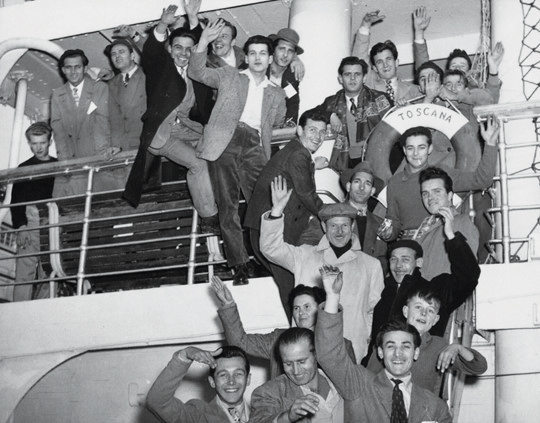Group of migrants on MV Toscana at Trieste, 1954 courtesy of the Australian National Maritime Museum.
By Lyn Forde – President/Research Officer of St Marys & District Historical Society Inc.
After World War Two, many Europeans chose to migrate to more appealing, safe and accessible locations and one location was Australia. Migrants fleeing from persecution in Soviet countries was known as Displaced Persons from Eastern Europe (included Poland, Yugoslavia, Latvia, Lithuania, Estonia, Ukraine, Czechoslovakia and Hungary) migrated to Australia. The Australian Government paid some or most of the fare for these migrants to relocate. Between 1945 and 1965 more than two million migrants moved to Australia assisted by the Australian Department of Immigration’s large-scale migration program. In the late 1950s they were followed by a large number of migrants from western Europe and these migrants worked on many large-scale projects including the building of the Snowy Mountains hydroelectricity scheme. Assisted migration to Australia in the 1960s mainly attracted British migrants known as “10-pound Poms” because the cost of an adult ticket was £10 and their children were free. Hostels in New South Wales included St Marys and Wallgrove. Migrants and their dependants were permitted to remain in the hostels from 3 to 12 months and were given training to assist with resettlement. Much of the early accommodation at St Marys and Wallgrove consisted of disused army huts at Wallgrove and at the former Australian Defence Industry buildings at St Marys. New South Wales State records note that the Wallgrove Migrant Hostel officially opened in April 1950 and closed in December 1952. This Hostel was one of 36 hostels in NSW. While official records are not readily available the sources indicate that the Wallgrove Hostel was once again in operation in the early 1960s to house British migrants. During its peak time of use the Wallgrove hostel could house around 2,500 people with four separate dining halls in use. Rental costs at Wallgrove Migrant Hostel were reportedly £3 a week for a working man, £2 for his wife and £1 for a child. Migrants were also entitled to government benefits including child endowment (family allowance), free hospital care and other social services. Unlike larger migrant camps like Bonegilla in Victoria and Bathurst in NSW, most of the Wallgrove camp accommodation would have been tough at times, having travelled far across the world to a foreign country, housed in ex-army facilities with other migrants from all over Europe with many who did not speak English. Transfer of new migrants between NSW camps was common and many families feared separation. Unfortunately this was a valid concern. While it is likely that the option for working men to live with their families at Wallgrove, some were provided with transport to and from Wallgrove but it was limited as Rooty Hill Station was over an hour’s walk away. In St Marys the Migrant Hostel had a better chance of the migrants living there with the closeness of work for the men and women and at the St Marys’ schools for their children to learn English and assimilate into the St Marys community. In January 1961 a visitor from Penrith, England was taking her first opportunity of visiting the Australian namesake of her English hometown, Miss Lisette Arnison aged 20 who was a journalist from Penrith, England visited Penrith, Australia. She arrived on M.V. “Fairsea” and after staying at Wallgrove for a few days she moved to Centennial Park and as so many English migrants have stated previously, Miss Arnison’s greatest impression of Australia was the cleanness of the cities. Prior to coming to Australia she was a reporter on the “Southern Reporter” a Scottish weekly paper in the border town of Selkirk.
Sources: National Archives online, Nepean Times 19 January 1961, Blacktown City Council online.




